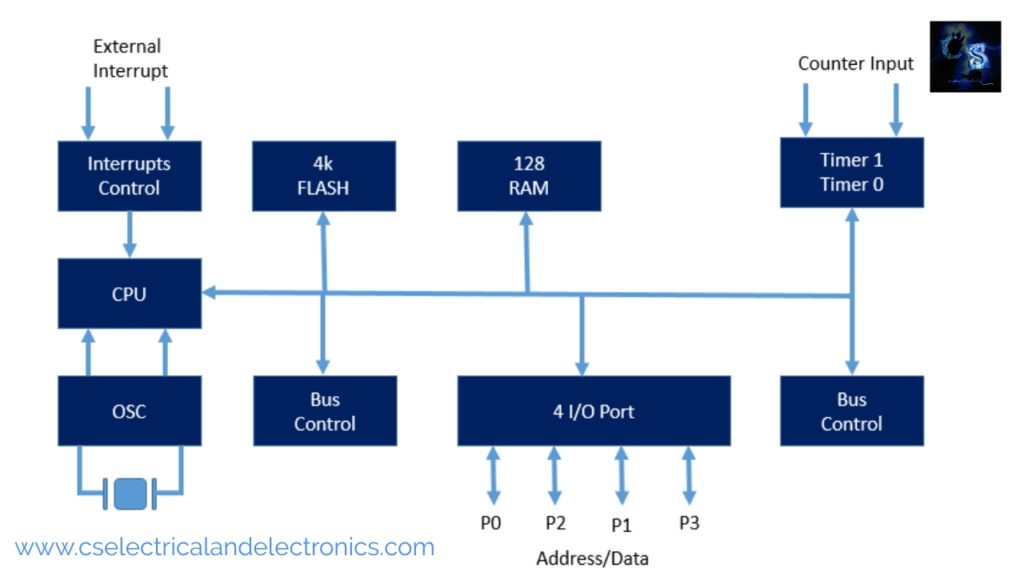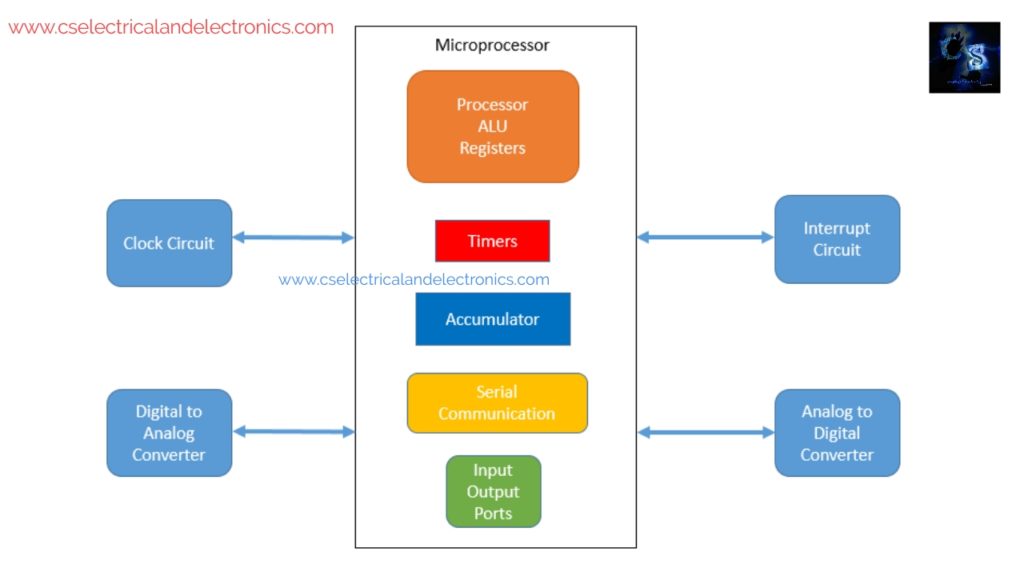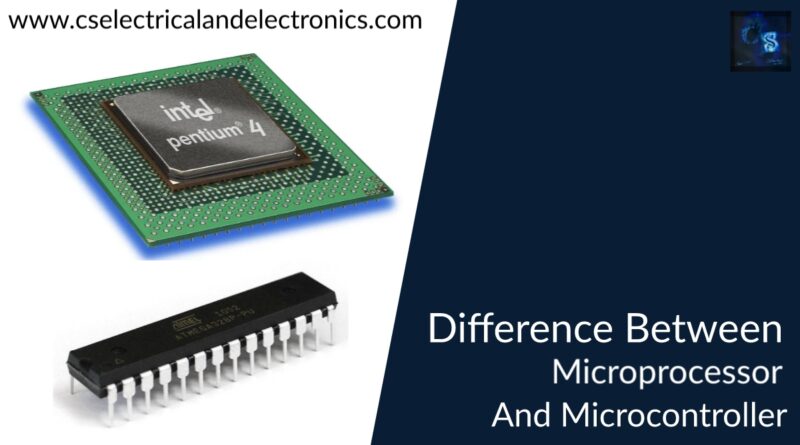Difference Between Microprocessors And Microcontrollers
Hello guys, welcome back to our blog. In this article, we will discuss the difference between microprocessors and microcontrollers, applications of microprocessors, and applications of microcontrollers.
If you have any electrical, electronics, and computer science doubts, then ask questions. You can also catch me on Instagram – CS Electrical & Electronics.
Also, read:
- Difference Between .Hex .Bin .Elf .Axf Files, Purpose, Examples
- Electronic Components Procurement, Top Steps To Follow Procurement
- Difference Between Device Driver And Application Programming
Difference Between Microprocessors And Microcontrollers
Microcontrollers
The microcontroller is nothing but it is a small computer on one metal oxide semiconductor integrated circuit chip. A single microcontroller consists of one or more CPUs, memory and programmable input, and output peripherals. Microcontrollers will be designed for embedded applications. This can be used in products that are automatically controlled like automobile engine control systems, implantable medical devices, remote controls, office machines, and various embedded systems.
A microcontroller can be with four-bit 8-bit 16-bit 32-bit or 64-bit processors. They can use volatile memories like RAM and nonvolatile memories like flash memories, erasable programmable read-only memory (EPROM), and Electrically erasable programmable read-only memory(EEPROM).
E.g 8051 microcontrollers, PIC microcontroller, MSP430, and many more.
The microcontroller includes a CPU, memory, input-output peripherals, analog to digital converter, system bus serial port, and crystal oscillators.
Working of microcontrollers

When you go to the power supply the crystal oscillator generates Clock pulses and frequency. Later the oscillator will get stabilized. Now the microcontroller will start working from the program counter. The address of the program counter is stored in ROM. The PC will store the address of the next instruction which has to be executed. It will perform the instructions from the start address of the program counter.
This address can be sent to the instruction decoder which understands and completes the instructions. The main advantage that you get by using a microcontroller is less cost and size and This is easy to design and deploy. The main disadvantage is it cannot withstand high voltage and it is very difficult to understand the architecture.
Applications of microcontrollers
- Microcontrollers can be used as digital signal processors.
- This can be used in various industries and in applications.
- Microcontrollers can be used in building automation, robotics, and many more.
- These can be used in battery management systems, to monitor the power level and currents.
- Microcontrollers can be used in railways to control doors and propulsion.
- This also can be employed in lifts and cranes.
Microprocessors
This is an integrated circuit chip that includes the core functions of a CPU. It will accept binary data as input and it gives the output after processing as per the instructions that are stored in the memory. This is similar to our brain which can be trained to do anything by programming that.
E.g X86, Motorola, Pentium, Intel4004, AMD Athlon many, Intel8085.
The microprocessor includes an arithmetic and logic unit, a control unit and resistor array, and input-output devices.
Types of microprocessors
- Vector processor
- Scalar and superscalar processor
- RISC processor (reduced instruction set computer. )
- CISC processor (complex instruction set computer )
- ASIC processor (application-specific integrated circuits. )
- SIMP processor.
Working of microprocessors

You have to give binary data as input the microprocessor processes this data and provides the output as per instructions. The data will be processed by an automatic and logical unit ( ALU ), Control Unit, and a resistor array. This resistor array processes the data through a number of resistors which will act as temporary fast access memory locations. The control unit manages the flow of instructions and data through the system.
Applications of microprocessors
- Microprocessors can be used in automobiles, trains, and planes.
- It can be used in all types of computers from microcomputers to supercomputers.
- It also can be used in an insulin pump.
- Used in function generators, frequency counters, and frequency synthesizers.
- The microprocessor can be used in home devices like washing machines and calculators
- telephone burglar alarms many more.
Difference Between Microprocessors And Microcontrollers
Microcontroller
- It uses a micro CPU that runs at low frequency.
- The time required to access the CPU register is less.
- Used in real-time applications.
- It supports the boolean operation.
- It supports bitwise operations.
- This is not suitable for multitasking.
- Operation speed is slow.
- All components are present inside the microcontroller.
- It is the heart of the embedded system.
- The system cost is low.
- These are having power-saving modes.
- E.g 8051 microcontrollers, PIC, MSP430 microcontroller, etc.
Microprocessor
- It uses a general-purpose CPU that runs at high frequency.
- The time required to access the CPU register is more.
- Used in personal desktops or laptops.
- The microprocessor doesn’t support boolean functions.
- It will not support bitwise operators.
- It is the best suitable for multitasking.
- Operation speed is fast.
- Some of the components of the microprocessor are outside.
- It is the heart of the computer system.
- The system cost is high.
- These are not having power-saving modes.
- E.g X86, Motorola, Pentium, Intel4004, AMD Athlon many.
This was about “Difference Between Microprocessors And Microcontrollers”. I hope this article may help you all a lot. Thank you for reading.
Also, read:
- 100 + Electrical Engineering Projects For Students, Engineers
- 1000+ Electronics Projects For Engineers, Diploma, MTech Students
- 1000+ MATLAB Simulink Projects For MTech, Engineering Students
- 500+ Embedded System Projects For Engineer, Diploma, MTech, PhD
- 500+ Projects For Diploma Electrical, Electronics Student, Diploma Project
- 8051 Microcontroller Timers, TCON Register, TMOD Register
- Advancements In 3D Printing Technology And It’s Future
- Advancements In Power Electronics For Energy Efficiency
Author Profile
- Chetu
- Interest's ~ Engineering | Entrepreneurship | Politics | History | Travelling | Content Writing | Technology | Cooking
Latest entries
 All PostsApril 19, 2024What Is Vector CANoe Tool, Why It Is Used In The Automotive Industry
All PostsApril 19, 2024What Is Vector CANoe Tool, Why It Is Used In The Automotive Industry All PostsApril 13, 2024What Is TCM, Transmission Control Module, Working, Purpose,
All PostsApril 13, 2024What Is TCM, Transmission Control Module, Working, Purpose, All PostsApril 12, 2024Top 100 HiL hardware in loop Interview Questions With Answers For Engineers
All PostsApril 12, 2024Top 100 HiL hardware in loop Interview Questions With Answers For Engineers All PostsMarch 22, 2024Driver Monitoring Systems In Vehicles, Working, Driver Sleepy Alert
All PostsMarch 22, 2024Driver Monitoring Systems In Vehicles, Working, Driver Sleepy Alert








